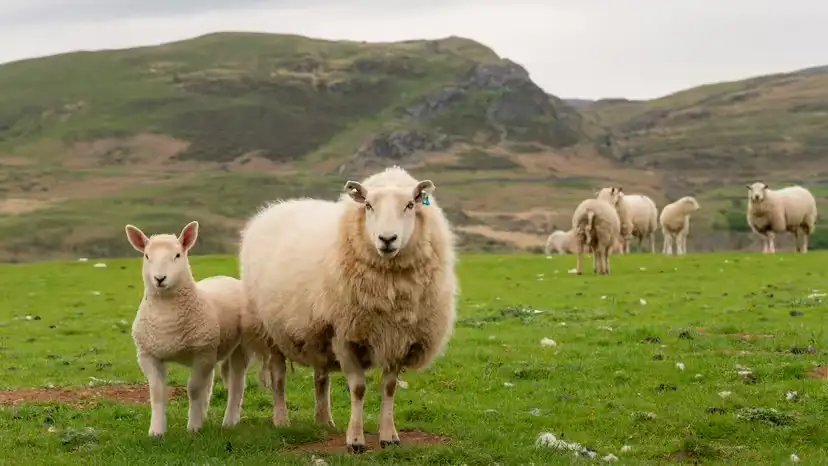Short answer: Lamb is a young sheep (under ~12 months) and also the retail name for its meat. Sheep is the species name (or adults of the species). Same animal, different life stages—yet the terms matter for farming, labeling, and flavor.
Domestic sheep (Ovis aries) are ruminants raised worldwide for meat, milk, and wool. They were domesticated from wild sheep thousands of years ago and remain central to pastoral agriculture.
Adult terms
Ewe: adult female
Ram (tup in some regions): adult male
Wether: castrated male (used for meat/wool/management)

Lamb is simply a young sheep, commonly under one year. In livestock practice, people also use ram lamb (young male) and ewe lamb (young female). As lambs transition from milk to forage, their milk teeth gradually give way to permanent teeth—a cue producers use to estimate age.
Some regions add a middle category: hogget (or “yearling mutton”), a juvenile between lamb and full adult. It often has more flavor than lamb but remains more tender than mutton.
| Dimension | Lamb | Sheep (adult/umbrella term) |
|---|---|---|
| Species | Ovis aries (same species) | Ovis aries |
| Age window | Typically < 12 months | ≥ 12 months (or generic species reference) |
| Meat term | Lamb | Mutton (adult sheep meat) |
| Texture & flavor | Tender, milder | Firmer, fuller “muttony” flavor |
| Best cooking | Quick, high-heat (grill, roast, pan-sear; also short braises) | Low & slow (braise, stew, slow-roast, pressure-cook) |
| Fiber/wool | First clip (“lamb’s wool”) often soft; quality still depends on breed & management | Graded by micron, length, crimp, cleanliness; Merino and kin prized for fine fiber |
Lamb: harvested under ~12 months; lighter color, fine grain, white, softer fat; prized for tenderness and delicate aroma.
Hogget (regional): juvenile; flavor between lamb and mutton, still reasonably tender.
Mutton: adult; darker meat, denser texture, stronger flavor—excellent for slow cooking and spice-forward cuisines.
Easy ID tips
Color: lamb = lighter red; mutton = deeper red.
Fat: lamb = white and fine; mutton = thicker, more ivory/yellow.
Aroma: lamb = gentle; mutton = richer, more pronounced.
Analogy: veal vs beef. Younger animals → milder flavor and softer texture.
Milk: Sheep milk is high in solids, ideal for cheeses like Feta, Roquefort, Pecorino.
Wool: Quality hinges on micron (fineness), staple length, crimp, and cleanliness. “Lamb’s wool” can be very soft, but breed (e.g., Merino vs. coarser meat breeds) and husbandry determine value.
Buying
Check the age grade (lamb/hogget/mutton), cut, country of origin, and cold-chain integrity.
For lamb, look for light red meat with clean white fat and tidy trimming.
Choose cuts that match your method: racks, loins, legs for quick or moderate cooking; shoulder, shanks for braises.
Cooking
Lamb: excels with high-heat roasting/grilling, quick pan-sears, or shorter braises. Avoid overcooking lean cuts.
Mutton: shines with marination, low & slow cooking, pressure-braising, and bold aromatics (rosemary, thyme, cumin, coriander, garlic, chiles).
Cultural/Religious standards
Halal/Kosher processing follows specific slaughter and handling rules that some buyers require or prefer.
“Lamb and sheep are different animals.”
False. Same species; “lamb” is the young age class.
“Lamb is always better than mutton.”
It depends on the dish. For long braises or big flavors, mutton can outperform lamb.
“Lamb’s wool is always premium.”
Not automatically. Breed and fiber grade matter more than age alone.
| Quick Need | Choose |
|---|---|
| Tender chops/steaks & delicate flavor | Lamb |
| Deep flavor for curries/stews/braises | Mutton (or hogget if available) |
| Soft next-to-skin knitwear | Fine-micron wool (often Merino), not just “lamb’s wool” |
| Cheese making | Sheep milk (high solids) |
What’s the core difference between lamb and sheep?
Age. Lamb is a young sheep (under ~12 months). “Sheep” is the species generally or adults specifically.
Why does mutton taste stronger?
With age, myoglobin, fat composition, and connective tissue increase, producing deeper flavor and a firmer bite—best released by slow cooking.
What is hogget?
A regional retail grade for juvenile sheep between lamb and mutton—flavorful yet not as tough as full mutton.
How do I pick good lamb?
Look for light red meat, clean white fat, precise trimming, reputable sourcing, and cuts that fit your cooking plan.
Is lamb’s wool always superior?
No. Micron, staple, crimp, and breed determine handfeel and value; many premium fibers come from fine-wool breeds regardless of first clip.
animal tags: Lamb vs Sheep
We created this article in conjunction with AI technology, then made sure it was fact-checked and edited by a Animals Top editor.